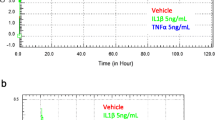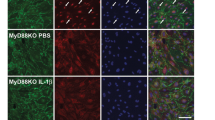Abstract
Recently, estrogens have been reported to have protective effects against experimental autoimmune encephalomyelitis (EAE), a murine model of multiple sclerosis (MS). Although the molecular mechanism for such a protective effect is currently incomplete, we hypothesized that estradiol may reduce the release of ATP from erythrocytes (ERYs), thereby lowering the production of nitric oxide (NO) by endothelial cells. Here, we report on the use of a microfluidic device to investigate the direct effects of the estrogen estradiol on endothelial cell nitric oxide production. In addition, the incorporation of a thin polycarbonate membrane into the device enabled the passage of ERYs through the device to determine indirect effects of estradiol on NO production that may be meditated by ERYs. When these ERYs were incubated with increasing concentrations of estradiol, the NO production from the endothelial cells was attenuated to a value that was only 59 ± 7% of ERYs in the absence of estradiol. This decrease in NO production coincides with reductions in ERY-derived ATP release in the presence of estradiol. Estradiol is typically reported to have NO-stimulating effects; however, such reports have employed in vitro experimental designs that include only a single cell type. To demonstrate the potential importance of this attenuation of ATP from ERYs, results from a small-scale study show that the ATP release obtained from healthy controls was 138 ± 21 nM (n = 18) while the release from the ERYs obtained from people with MS was 375 ± 51 nM (n = 11). The studies reported here involving multiple cells types (endothelial cells and ERYs) may lead to a reappraisal of the in vivo activities of estradiol.




Similar content being viewed by others
References
Furchgott RF, Zawadzki JV (1980) The obligatory role of endothelial cells in the relaxation of arterial smooth muscle by acetylcholine. Nature 288:373–376
Palmer R, Ferrige MJ, Moncada S (1987) Nitric oxide release accounts for the biological activity of endothelium-derived relaxation factor. Nature 327:524–526
Ignarro LJ, Byrns RE, Buga GM, Wood KS (1987) Endothelium-derived relaxing factor from pulmonary artery and vein possesses pharmacologic and chemical properties identical to those of nitric oxide radical. Circ Res 61:866–879
Liang G, Stephenson AH, Lonigro AJ, Sprague RS (2005) Erythrocytes of humans with cystic fibrosis fail to stimulate nitric oxide synthesis in isolated rabbit lungs. Am J Physiol 288:H1580–H1585
Sprague RS, Ellsworth ML, Stephenson AH, Lonigro AJ (1996) ATP: the red blood cell link to NO and local control of the pulmonary circulation. Am J Physiol 271:H2717–H2722
Giovannoni G, Heales SJR, Land JM, Thompson EJ (1998) The potential role of nitric oxide in multiple sclerosis. Mult Scler 4:212–216
Confavreux C, Hutchinson M, Hours MM, Cortinovis-Tourniaire P, Moreau T (1998) Rate of pregnancy-related relapse in multiple sclerosis. N Engl J Med 339:285–291
Tiwari-Woodward S, Morales LBJ, Lee R, Voskuhl RR (2007) Differential neuroprotective and antiinflammatory effects of estrogen receptor (ER)a and ERb ligand treatment. Proc Natl Acad Sci USA 104:14813–14818
Jaubert AM, Mehebik-Mojaat N, Lacasa D, Sabourault D, Giudicelli Y, Ribiere C (2007) Nongenomic estrogen effects on nitric oxide synthase activity in rat adipocytes. Endocrinology 148:2444–2452
Scott PA, Tremblay A, Brochu M, St-Louis J (2007) Vasorelaxant action of 17 beta-estradiol in rat uterine arteries: role of nitric oxide synthases and estrogen receptors. Am J Physiol-Heart Circ Physiol 293:H3713–H3719
Oblak T, Root PD, Spence DM (2006) Fluorescence monitoring of ATP-stimulated, endothelium-derived nitric oxide production in channels of a poly(dimethylsiloxane)-based microfluidic device. Anal Chem 78:3193–3197
Sprague RS, Ellsworth ML, Stephenson AH, Lonigro AJ (1996) ATP: the red blood cell link to NO and local control of the pulmonary circulation. American Journal of Physiology-Heart Circ Physiol 271:H2717–H2722
Carroll J, Ku CJ, Karunarathne W, Spence D (2007) Red blood cell stimulation of platelet nitric oxide production indicated by quantitative monitoring of the communication between cells in the bloodstream. Anal Chem 79:5133–5138
Ku C-J, D'Amico Oblak T, Spence DM (2008) Interactions between multiple cell types in parallel microfluidic channels: monitoring platelet adhesion to an endothelium in the presence of an anti-adhesion drug. Anal Chem 80:7543–7548
Ku C-J, Karunarathne W, Kenyon S, Root P, Spence D (2007) Fluorescence determination of nitric oxide production in stimulated and activated platelets. Anal Chem 79:2421–2426
Genes LI, Tolan NV, Hulvey MK, Martin RS, Spence DM (2007) Addressing a vascular endothelium array with blood components using underlying microfluidic channels. Lab Chip 7:1256–1259
McDonald JC, Duffy DC, Anderson JR, Chiu DT, Wu H, Schueller OJA, Whitesides GM (2000) Fabrication of microfluidic systems in poly(dimethylsiloxane). Electrophoresis 21:27–40
Sprung RJ, Sprague RS, Spence DM (2002) Determination of ATP release from erythrocytes using microbore tubing as a model of resistance vessels in vivo. Anal Chem 74:2274–2278
Douville NJ, Tung YC, Li R, Wang JD, El-Sayed ME, Takayama S (2010) Fabrication of two-layered channel system with embedded electrodes to measure resistance across epithelial and endothelial barriers. Anal Chem 82:2505–11
Tolan NV, Genes LI, Subasinghe W, Raththagala M, Spence DM (2009) Personalized metabolic assessment of erythrocytes using microfluidic delivery to an array of luminescent wells. Anal Chem 81:3102–3108
Stamler JS, Jia L, Eu JP, Mcmahon TJ, Demchenko IT, Bonaventura J, Gernert K, Piantadosi CA (1997) Blood flow regulation by S-nitrosohemoglobin: a dynamic activity of blood involved in vascular control. Science 276:2034–2037
Gow AJ, Stamler JS (1998) Reactions between nitric oxide and haemoglobin under physiological conditions. Nature 391:169–173
Jia L, Bonaventura C, Bonaventura J, Stamler JS (1996) S-nitrosohaemoglobin: a dynamic activity of blood involved in vascular control. Nature 380:221–226
Minneci PC, Deans KJ, Shiva S, Zhi H, Banks S, Kern S, Natanson C, Solomon SB, Gladwin MT (2008) Nitrite reductase activity of hemoglobin as a systemic nitric oxide generator mechanism to detoxify plasma hemoglobin produced during hemolysis. Am J Physiol 295:H743–H754
Spence DM, Torrence NJ, Kovarik ML, Martin RS (2004) Amperometric determination of nitric oxide derived from pulmonary artery endothelial cells immobilized in a microchip channel. Analyst 129:995–1000
Sprague RS, Olearczyk JJ, Spence DM, Stephenson AH, Sprung RW, Lonigro AJ (2003) Extracellular ATP signaling in the rabbit lung: erythrocytes as determinants of vascular resistance. American Journal of Physiology-Heart and Circulatory Physiology 285:H693–H700
Subasinghe W, Spence DM (2008) Simultaneous determination of cell aging and ATP release from erythrocytes and its implications in type 2 diabetes. Anal Chim Acta 618:227–233
Jansson L, Olsson T, Holmdahl R (1994) Estrogen induces a potent suppression of experimental autoimmune encephalomyelitis and collagen-induced arthritis in mice. J Neuroimmunol 53:203–207
Gold SM, Voskuhl RR (2009) Estrogen treatment in multiple sclerosis. J Neurol Sci 286:99–103
Cunnane SC, Ho S-Y, Dore-Duffy P, Ells KR, Horrobin DF (1989) Essential fatty acid and lipid profiles in plasma and erythrocytes in patients with multiple sclerosis. Am J Clin Nutr 50:801–806
Dore-Duffy P, Catalanotto FA, Lisak RP (1986) Zinc in multiple sclerosis II: correlation with disease activity and elevated plasma membrane-bound zinc in erythrocytes from patients with multiple sclerosis. Ann Neurol 20:712–715
Raczkiewicz J, Leyko W (1966) Adenine nucleotide content of erythrocytes of multiple sclerosis patients. Clin Chim Acta 14:408–409
Author information
Authors and Affiliations
Corresponding author
Rights and permissions
About this article
Cite this article
Letourneau, S., Hernandez, L., Faris, A.N. et al. Evaluating the effects of estradiol on endothelial nitric oxide stimulated by erythrocyte-derived ATP using a microfluidic approach. Anal Bioanal Chem 397, 3369–3375 (2010). https://doi.org/10.1007/s00216-010-3687-7
Received:
Revised:
Accepted:
Published:
Issue Date:
DOI: https://doi.org/10.1007/s00216-010-3687-7




